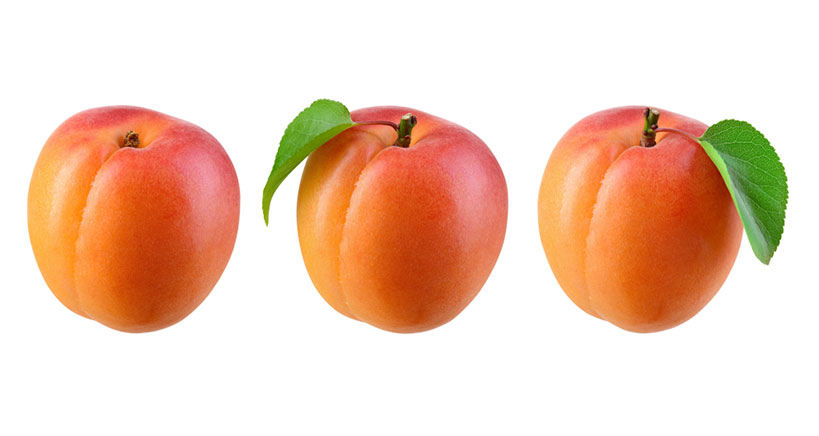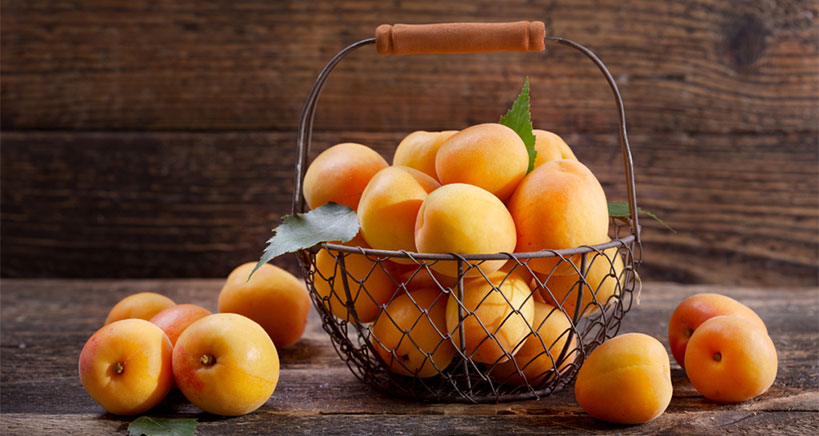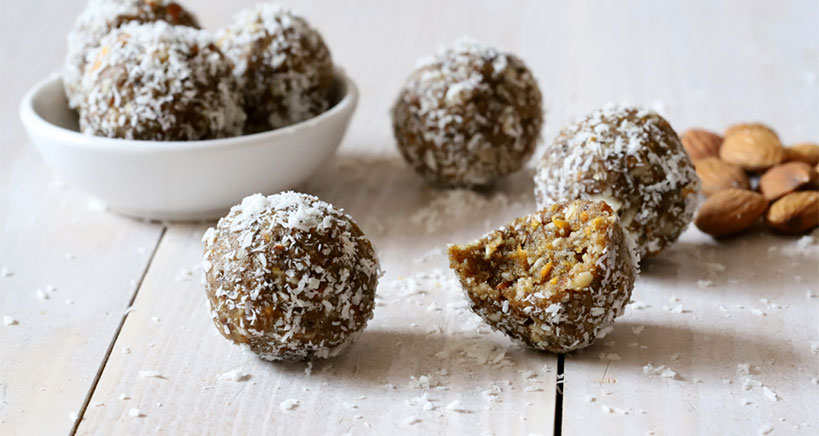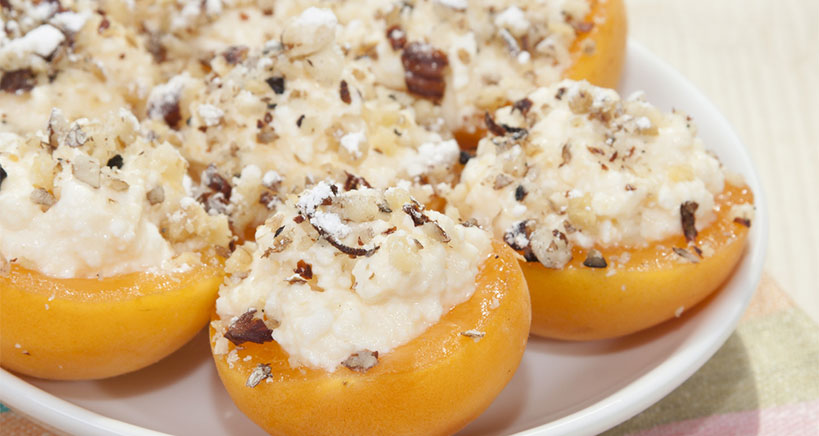
Whether you eat them raw, dried, or canned, there are countless ways to enjoy the healthy, tasty apricot. In fact, apricots are used to prepare a wide array of savory side dishes, sauces, oils, jams, and desserts. If you are a gourmet chef, professional baker, or own a restaurant or catering service, this blog will give you the 411 on cooking and baking with apricots. In addition, as we shine a sweet spotlight on this tart fruit, you will enjoy a myriad of new recipes to add to your menu while your customers enjoy being pampered by your new delightful apricot offerings.
Apricot Basics
Scientifically known as Prunus armeniaca, the apricot fruit has a thin, fuzzy, yellow or orange exterior with a tangy flesh and inedible pit inside. Less juicy – and hence less messy – than their peach, plum, and nectarine counterparts, they are perfect as a healthy snack and can be easily added to numerous recipes. Apricot oil can also be extracted from its kernel (seed) and like the fruit itself, it is packed with healthy benefits.
Apricot Nutritional Value
Nutritionally, according to United States Department of Agriculture statistics, 100 grams of fresh apricots (about 3-4 individual fruits) contains only 50 calories, but boasts 1.4 grams protein, a negligible 0.39 grams fat, 11.12 grams carbohydrates, 2 grams fiber, and 9.2 grams sugar. It also contains 6% of the body’s daily requirement of potassium and 12% of vitamins A and C.
Apricot Health Benefits
Did you know that the tiny apricot packs a mighty nutritional punch? Similar to figs, perhaps one of the best-kept secrets in the world of fruit, apricots are choc-full of vitamins, fiber, and antioxidants, making them an edible way to lower the risk of heart disease and cholesterol, enhance vision, ease digestion, aid in weight loss, improve skin health, and even protect against cancer. The dietary fiber in apricots alone (3 grams per cup) is enough to help prevent constipation and bloating, increase metabolism, and make the body full fuller for longer. Fiber is also food for the heart, helping regulate blood pressure and cholesterol levels.
Adding to its assets, given that apricots have a low glycemic index and that a single apricot is low in carbs and in calories (4 grams of carbohydrates and a mere 17 calories), apricots are also recommended as part of a diabetic diet.

Additional health benefits include apricots’ vitamin A content, which boosts eye health and helps with acne and other skin problems, while its iron content helps treat anemia and increases hemoglobin (red blood cell) production. Rich in calcium, apricots boost bone health, while their potassium levels aid in the proper absorption and distribution of calcium. Some studies show that dried apricots can reverse bone loss and alter bone metabolism in postmenopausal women. Finally, apricots’ variety of antioxidants work as an anti-inflammatory and improve skin and hair health.
Adding Apricots to Your Foodservice Menu
There are multiple ways to add fresh, dried, and pureed apricots to recipes and favorite dishes. Some tasty ideas to liven up your restaurant menu include:
- Add chopped fresh or dried apricots to cold and hot morning cereals
- Make apricot yogurt by blending the fresh fruit with plain yogurt
- Use blended apricots as a dip or as a sweet spread on bread or toast
- Make apricot jams and preserves, including unsweetened versions made without added sugar
- Add fresh or dried apricots to salads for a sweet, healthy, and colorful kick
- Try your hand at a delicious recipe that combines chopped apricots, assorted green vegetable leaves, feta cheese, almonds, and a sprinkling of balsamic dressing on top
- Use in salsas
- Stew in a slow cooker with chicken
- Use apricot puree as a tasty basis for hot sauces in cooking and for cake icing in baking
- Embark upon a baking bonanza with recipes for apricot pie, apricot cake, apricot crumble, apricot tarts, apricot muffins, apricot-almond cookies, and more
- Add dried apricots to your customers’ favorite trail mixes
- Make apricot ice cream
- Get decadent with Chocolate Dried Fruit Bars
- Replace the fresh fruit with canned apricots in many recipes
- Use as a recipe substitute for peaches or plums
Apricot History
Apricots boast a lengthy history with multiple theories regarding its origins. Some claim that the fruit was first cultivated in India as far back as 3000 BC. Others credit its origins to ancient China and then Persia. There is also much evidence of the fruit being cultivated during ancient times in Armenia. There is no dispute, however, about its popularity and benefits, which became more prominent after Spanish explorers introduced the fruit to the Americas. Today, Iran is a major global supplier of dried apricots, while leading producers of the fresh fruit include the USA, France, Turkey, Spain, Italy, and Russia.

Jamming with Apricot Jam Recipes
Not only have small apricots proven to be a formidable force in the realm of fruits, but apricot jam is increasingly being used by leading chefs and bakers with multiple apricot jam recipes available. Experiment with versions made with and without the skins, with frozen and dried apricots, with Martha Stewart apricot jam, and even French apricot jam which uses sprigs of lavender from sunny Provence to add a subtle lavender flavor to the finished product that also discourages mold.
Your chefs can also make their own apricot jam with two or three simple ingredients: apricots, lemon juice, and optional sugar. Any which way it is prepared, apricot jams and preserves are delicious when spread on bread, toast, French toast, pancakes, scones, English muffins, rice cakes, crackers, and croissants. The jam can also be baked into thumbprint cookies, used to fill tarts, as a spread between cake layers, or as a delicious finish to a fresh sponge cake.
Apricot Seed Benefits
Did you know that the apricot kernel or seed contains significant amounts of protein, fiber, and a high percentage of oil? In fact, the oil extracted from the kernel, producing apricot seed oil, can be used in cooking, while many of today’s processed foods (i.e. biscuits and jams) are made from apricot kernels.
Moreover, the apricot seed (found inside the pit or stone of an apricot) has been gaining a reputation as a new ‘superfood’ capable of fighting cancer and aiding in the detox process. While the jury is still out regarding these claims, the facts are that nutritionally, apricot kernels are comprised of up to 45% protein, including essential amino acids, 28% carbohydrates, 5% fiber, and an especially high 27.7-66.7% of essential fatty acids, which are necessary for human health but which the body cannot independently produce and must be obtained through diet. Apricot seed oil, in turn, is rich in vitamin E, which according to the National Institutes of Health has important antioxidant properties.
And if you are interested in some more apricot seed trivia, check out the following:
- In Egypt, coriander seeds and salt are mixed with ground apricot kernel to make a traditional snack called “dokka”
- In the North-West Himalayas, wild apricots and their kernels have long been used nutritionally, medicinally, and cosmetically, including the making of skin and hair products
- In India, apricot kernel oil is used to make massage oil that relives aches and pains
Recommended Apricot Recipes
And now what you’ve all been waiting for… Some delectable apricot recipes to add to your chef’s repertoires, catering service, and restaurant menus. Bon Appétit and enjoy!

No-Bake Apricot Almond Bites (the best natural candy made from simple fruit and nuts)
Ingredients
- 1 1/2 cups dried apricots
- 1/2 cup unsweetened coconut flakes
- 12 almonds, pecans, or cashew
- Additional 1/4 cup coconut flakes for rolling
Instructions
- Blend or mix apricots and coconut flakes until thoroughly combined in a sticky mass
- Using a spoon, scoop out balls of the mixture, pressing a nut into the center of each bite. Cover with more mixture and roll until smooth
- Coat each bite with additional coconut
- Lay on parchment sheet and cover with additional sheet
- Refrigerate and serve!

Fresh Apricot Cake
Ingredients
- 14 medium apricots
- 2/3 cup butter
- 1 cup sugar
- 1 tsp. vanilla
- 3 eggs
- Optional: zest from 1 medium lemon
- 2 cups flour
- 2 tsp. baking powder
- 1/2 tsp. salt
- 1/4 cup buttermilk
- Optional 2 tbsp. sugar for sprinkling
- 2 tbsp. apricot or strawberry jam for glazing
Instructions
- Preheat oven to 350°F (175° C)
- Line a 9 x 9-inch or 11-inch baking pan with parchment
- Halve the apricots
- In a large bowl, cream butter, sugar and vanilla together
- Add eggs one at a time, beating well after each addition
- In a medium bowl, combine the flour, lemon zest, baking powder, and salt. Sift into the butter/egg mixture, beating well.
- Add the buttermilk and remix
- Spread batter evenly into the pan. With the cut side facing down, place the halved apricots on top of the batter (in rows or circles)
- Sprinkle with optional sugar
- Bake 30-40 minutes
- Melt the jam for glazing over low heat and spread over the cake while both are still hot
- Serve freshly baked or warm with vanilla ice cream on top
- Store cake in refrigerator to avoid spoilage
BAKERS TIP: You can pre-cook and freeze apricots to use for this recipe and others

Gluten-Free Stuffed Apricot Appetizers
Ingredients
- 24 dried apricots
- 1/2 cup ricotta cheese
- 1/4 cup pomegranate seeds
- 1/4 cup honey
Instructions
- Spread approximately 1 tsp. ricotta cheese on each dried apricot
- Sprinkle a few pomegranate seeds on top of each
- Chill the apricots in the fridge before serving
- At serving time, drizzle a dab of honey over each appetizer
- Enjoy!